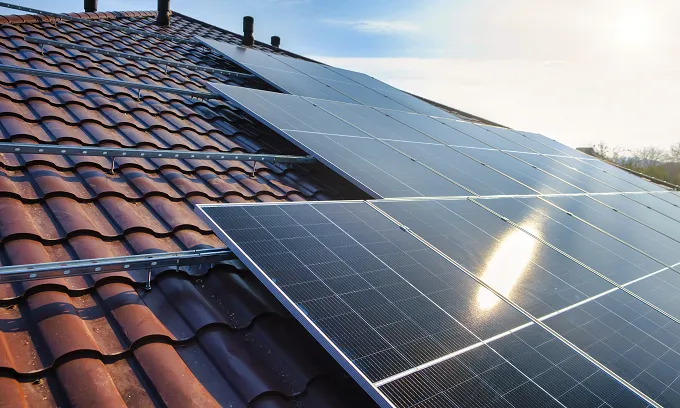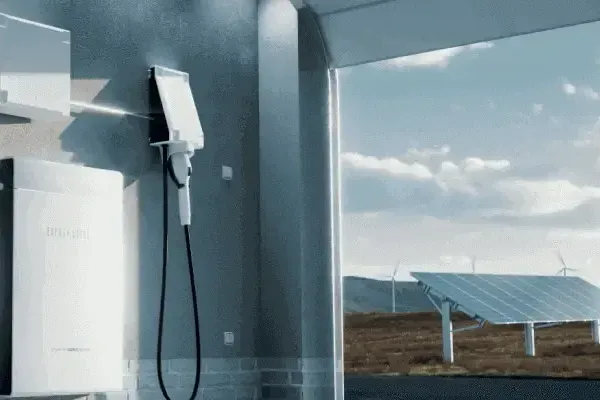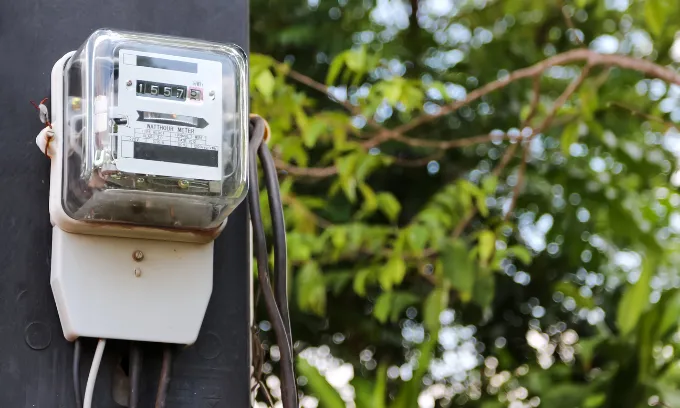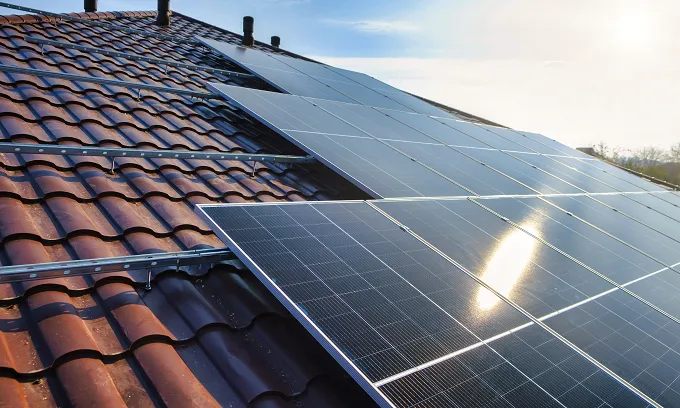What is a solar feed-in tariff?
A solar feed-in tariff (FiT) is a bill credit paid for every kilowatt hour (kWh) of excess solar a customer exports to the grid. To qualify for a solar FiT, you’ll need to own a rooftop solar system.
For example, a household with solar panels may produce 16kWh of electricity on a sunny day. If the household consumes 10kWh of this electricity, the remaining 6kWh will be exported to the grid for a solar FiT.
Exported solar reduces the strain on the electricity grid during times of high demand. For customers, FiTs are an opportunity to receive a small rebate on their power bills. This can save you money on electricity and help you achieve a return on your investment faster.
If you have solar panels, it’s important to factor in both the standard electricity usage rates and the solar FiT offered on your energy plan.
What are solar feed-in tariff rates?
Solar FiT rates refer to the value in cents of the bill credit, which varies based on the electricity retailer and distribution network. FiTs are advertised as a feature on some electricity plans.
Distributors are in charge of supplying electricity to homes and maintaining grid infrastructure (e.g. utility poles). Distribution networks refer to areas covered by a single distributor within each state.
While electricity prices and FiTs will vary across distributors, the rates you pay and the FiT you receive are decided by your electricity provider. This is the company that you buy your energy plan from (e.g. AGL or Origin).
The majority of solar plans offer customers a FiT of 1c/kWh to 14c/kWh, depending on the state and plan.
However, how these rates are set or structured can differ significantly.
Types of solar feed-in tariffs
Flat solar feed-in tariffs
Flat solar FiTs pay customers a flat rate (in c/kWh) for their exported solar, regardless of the time of day or amount exported. This is the most common type of FiT offered on electricity plans.
Variable solar feed-in tariffs
Variable solar FiTs offer higher rates for a fixed amount of excess solar before reverting to a lower rate daily (e.g. 12c/kWh for the first 10kWh, 4c/kWh after).
A variable solar FiT could be the right choice if your rooftop solar exports below the solar threshold every day — that means you’ll always be paid the highest rate for your daily exports.
Time of use solar feed-in tariffs
A time of use FiT means that the customer receives the highest FiT when exporting during peak demand periods (e.g. 4pm-9pm weekdays) and the lowest FiT when exporting at off-peak times (e.g. 10am-2pm).
If your solar system includes a solar battery, then a time of use FiT could be best. Solar that’s generated throughout the day can be stored and exported during peak times when the solar FiT is highest.
However, regulation changes in July 2025 saw minimum FiTs lowered to 0c in some states, which might mean exporting during off-peak times brings you no financial benefit.
Premium solar feed-in tariffs
Note: Premium solar FiTs are no longer available for new customers
Premium FiTs of 40c/kWh and above are only available for current eligible Solar Bonus Scheme customers in South East Queensland and South Australia, however, the scheme is only accessible to those customers until 2028.
Victorian’s bonus scheme ended in 2024 and New South Wales’ equivalent scheme in 2016. All customers were reverted to the standard FiT in those states once their schemes expired.
Will a solar feed-in tariff save me money?
If you already own a rooftop solar system, a solar FiT is one of a few possible ways you can save money.
However, a higher solar FiT won’t necessarily mean a better deal.
For example, a high solar FiT could be compensating for higher electricity rates or lower discounts — this could mean you’ll be left paying more than you’re saving.
Therefore, a solar FiT pays you for your excess solar, but doesn’t guarantee savings.
Whether or not a solar FiT saves you money will be impacted by the following:
How much you spend on your rooftop solar system
If you don’t own a rooftop solar system, consider its payback period.
The solar system's payback period is the duration it takes for the earnings generated by solar power to equal its purchase and installation costs.
Your purchase and installation costs will typically be influenced by:
- Solar system components: How much you spend will depend on the brand, size and model (e.g. solar panels, inverter or optionally, a solar battery).
- Solar rebates: Solar rebates are discounts to support customers making the switch to solar. Depending on where you live, some state governments (including the federal government) may offer them to eligible customers.
E.g. $15,000 (cost of solar system components) - $3,000 (value of solar rebate)= $12,000 (total upfront spend).
Your solar FiT earnings will also depend on:
- The rate of your chosen solar FiT.
- Solar metering charges (if applicable): These are daily supply charges that certain retailers apply to solar customers.
- Sun tax (only if applicable): In some states, a sun tax (or a two-way tariff) charges you for exporting excess solar to the grid during hours when it is overloaded (e.g. between 10am and 3pm). The sun tax will differ between states and distributors. Currently, the sun tax is active in NSW.
- Volume of excess solar: The volume of excess solar depends on your solar system’s size and how much solar energy your home consumes. To monitor your solar exports, you can consider installing a power usage monitor, allowing you to do so in real time. Depending on your provider, you may have free access to an app with solar monitoring features.
E.g. 8c/kWh (the rate of your chosen solar FiT) X 22,500kWh (volume of excess solar monitored) = $1,800 (estimate solar FiT earnings annually).
To calculate your solar payback period, divide your system cost (total cost minus rebates/incentives) by your estimated annual solar FiT earnings.
E.g. $12,000 (total upfront spend) ÷ $1,800 (estimate solar FiT earnings annually) = 6.7 years (payback period).
The more you spend upfront, the longer the payback period. That means you won’t see ‘real’ earnings until the payback period is over.
Electricity rates versus solar feed-in tariffs
Once you’ve considered your solar system’s payback period, it’s time to consider your plan’s electricity rates. On every electricity plan, you can expect to see the following charges:
- Supply charges: This is a fixed cost (in c/day) you pay to maintain your connection to the grid, irrespective of how much electricity you use.
- Usage charges: An ongoing cost in cents for every kWh of electricity consumed.
As mentioned earlier, if a higher FiT is concealing even higher base rates, how much you’re spending on electricity could surpass how much you’re earning.
For example, if a plan has a solar FiT worth 8c/kWh, increases to your usage or supply charges that exceed the earnings from a FiT will not save you money. This is especially true if you own a small solar system (around 2kW-4 kW).
However, a large enough solar system (5kW and above) could justify higher electricity rates, provided the leap in FiT earnings exceeds your electricity spend.
An alternative to exporting excess solar power is storing it in a battery to power your home when lighting conditions are dim.
Discounts vs solar feed-in tariffs
Deciding between an energy plan with a discount on its usage rates or a higher solar FiT will depend on your individual energy habits.
Consider choosing the higher FiT if:
- You have a large solar system (5kW or more).
- A lot of solar is exported to the grid from your house because no one is home during the day to use it.
- There are conditions attached to receiving the discount that you’re not sure you can meet.
Consider choosing the higher discount if:
- You have a small solar system (less than 5kW).
- You use most of your solar power through the day and export very little to the grid.
- You own a solar storage battery.
As discussed earlier, solar monitoring technology can give you insights into your electricity usage habits.
Mapping your energy usage can help you make a better-informed decision.
How do I sign up for a solar feed-in tariff?
To sign up for a solar FiT, you must have solar panels installed by a licensed solar panel installer.
Different states have different size requirements, but usually the system must be less than 100kW, though most are between 3kW and 13kW.
Once your system is installed and signed off, you then need to apply to your electricity retailer to receive a solar FiT.
Retailers will generally require you to complete a solar connection form and produce the relevant paperwork that shows the installation was done by a licensed professional.
Your meter may also need to be upgraded to a smart meter so that it can digitally measure your solar exports. In all states, Aussies can no longer opt out of a smart meter upgrade.
Once those steps are completed, you can sign up for a new electricity plan that suits your home’s solar needs.
If you’re comparing solar electricity plans on our energy comparison platform, we’ll guide you from start to finish, simplifying the sign-up process.
Do I receive a solar feed-in tariff if I’m renting?
If you are renting a house with solar panels, then you should receive the associated solar FiT for the electricity the house exports to the grid.
If you live in an apartment or townhouse, you’ll need to have an electricity meter separate from the rest of the complex to have a solar FiT applied. This is so your electricity usage and solar exports can be measured and billed accordingly.
Make sure you read the terms and conditions of your rental agreement just in case the landlord has specifically requested that tenants not receive a solar FiT.
How do I find a good solar energy provider?
A good solar energy provider doesn’t just offer competitive solar FiTs, but high-quality customer service and support.
At Canstar, we rate and rank solar providers across Australia based on surveyed feedback from ordinary Aussies.
Most Satisfied Customers Award Winner - Solar Electricity Providers 2025
Lumo Energy arrives at the top of our 2025 customer satisfaction ratings for solar power providers in Australia. Lumo Energy scored five stars for overall customer satisfaction, customer service, bill and cost clarity and ease of sign-up.
For more details on solar FiTs in your state, feel free to visit the pages below:








